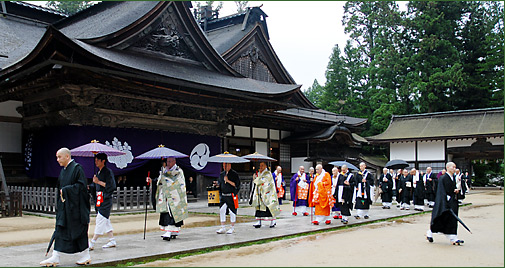“In 2015, Koyasan will celebrate 1200 years since its esoteric Buddhist dojo was opened by Kobo Daishi Kukai. In this memorable year, for 50 days from April 2nd to May 21st at Koyasan, we will hold a splendid memorial service in gratitude to the great heritage left to us by Kobo Daishi Kukai. Kobo Daishi chose Koyasan in the Kii mountain range, surrounded by great nature and far from the hustle and bustle of the city to build his esoteric dojo. Kobo Daishi was motivated by the desire to educate people who would work for the happiness of others and pray for eternal peace and security for the country and society. Reaching this great 1,200 year milestone, the door is now open to the a new era in the next hundred years or thousand years. We look forward to seeing you at Koyasan in 2015, with events that convey the history and appeal of this great memorial.”
Archbishop Matsunaga Yukei, 412th Chief Abbot of Kongobuji
Experience a temple stay at Koyasan, Japan — sacred mountain and UNESCO pilgrimage site (one of just a handful of UNESCO Pilgrimage Routes, the others are the Way of St. James in Spain, and the Birthplace of Jesus in Bethlehem) — marking its 1,200-year anniversary in 2015. This is just one of the highlights of Ancient Sacred Sites of Japan, May 5 to 15, 2015, designed and led by John Carpenter, Curator of Japanese Art at The Metropolitan Museum of Art. Part of the living culture of Japan, Koyasan is a spiritual center and World Heritage Site, where you can stay in a 1,000-year-old temple, dine with monks, bathe in Japan’s oldest hot spring, stroll through a village, and admire a sacred waterfall, all evocatively set in a temperate rainforest on the Kii Peninsula (our equivalent would be Sitka, Alaska or Vancouver). Not just a place for the ancient and religious, SANNA (aka Japanese architects Kazuyo Sejima + Ryue Nishizawa) built their first project, the very modern Kumano Kodo Kakahechi Art Museum, along the pilgrimage route leading to the ancient capital cities of Nara and Kyoto. UNESCO designated the complex of shrines, monasteries, and stone paths crisscrossing the mountain “Sacred Sites and Pilgrimage Routes in the Kii Mountain Range” in 2004.
Ancient Sacred Sites of Japan, May 5-15 2015. $11,995
Designed by John Carpenter, Curator of Japanese Art at the Met, this 11-day program includes a temple stay in Koyasan, and an overnight at a ryokan or traditional Japanese guesthouse in Kawayu Onsen, where pilgrims settle into hot baths along the geothermally heated Oto River. The tour also features private viewings, curator-led visits and hand-picked sites in Nara, capital of Japan from 710 to 784, and Kyoto, center of Japanese culture for more than 1,000 years. With a particular interest in ceramics, Carpenter opens doors for us too at workshops of modern artists. In addition to traditional Japanese accommodations, we stay three nights each at the historic Hotel Nara and newly opened Ritz-Carleton in Kyoto, set on the Kamogawa River.
Another feature of the trip will be a tea ceremony in the tea room at the Raku Kichizaemon Pavilion at the Sagawa Art Museum on May 13, hosted by Raku Kichizaemon XV, 15th generation of a line of master ceramicists that goes back to the original 16th-century master Chojiro. Created to display his work, the Raku Kichizaemon-Kan (tearoom and gallery) at the Sagawa Art Museum on the shore of Lake Biwa outside Kyoto was designed by Raku with Japan’s oldest architectural firm. The Canadian garden photographer Allan Mandel wrote recently about the experience, “Sublime, the tea room and raku/weaving exhibit were nothing short of ethereal and transcendent, ranking among the best art museum experiences I’ve ever had.”
Images courtesy of
Koyasan Shingon Buddhism Sohonzan Kongobuji – 金剛峯寺
- Comment
- Reblog
-
Subscribe
Subscribed
Already have a WordPress.com account? Log in now.



